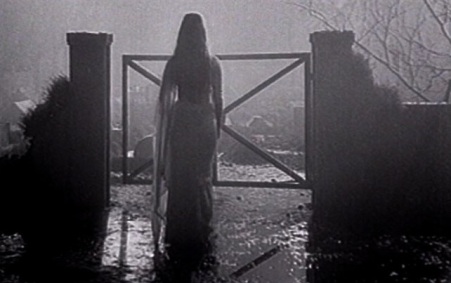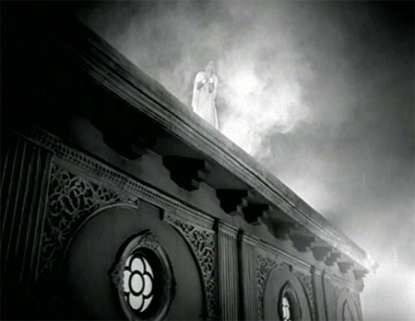In the U.S. historians and film theorists have debated for decades about the meaning of the elusive term: “film noir.” Although many of us conjure an image of a hard-boiled detective and a mystery made more mysterious by the femme fatale, few “film noirs” actually contain these elements. This so-called genre had its roots in German Expressionism with films like Fritz Lang’s M (1931) and in depression-era crime novels. But what does the term “film noir” mean as it applies to Hindi cinema? What are the hallmarks of this genre as it played out in Bollywood and how did it begin?
I will present five films that I propose to be in the genre of Indian film noir. This is no easy task. Just as the term is vague in the American lexicon, so too does it only hazily engulf a variety of Hindi films with low-key lighting. And so I shall begin with an illustrative example. We can debate the precise definition of the genre until the end of time, but I think I can safely say that whatever Indian film noir is, Woh Kaun Thi? (1964) is Indian film noir.
Woh Kaun Thi? has 4 main basic elements. The first is in its distinct cinematographic style and setting—low-key lighting throughout a mysterious mansion and slow unhurried shots with a somber film score to match. The film gives a sense of the world being trapped in a fatalistic dream, whether alone by a graveyard or in a crowd of dancing people.
The second is the film’s overall tone and pacing—there is an uncomfortable sense of being pursued, of an impending doom unless a mystery is solved in time by the hero. Unlike in American film noir, the hero is no cynic and there is no quick sardonic dialogue to off-set the dreary mood. The hero is instead a righteous and innocent man of affairs, an heir to a fortune who becomes a victim. Though mingled with occasional musical highs, the film spirals from a slow and deliberate set-up to a climax closer and closer to complete ruin.
An interesting element of many American film noirs is the flash-back structure, which takes on an interesting form in their Indian counterparts. Woh Kaun Thi? centers around a mysterious background that occurred in the protagonist’s past life. Because the audience of Hindi films was largely composed of practicing Hindus, the world of reincarnation narrative is able to begin on a new and creatively extremely fertile ground. The hero must revisit through song, hearsay, and secrets events that took place in a past life, but whose consequences (whether karma or otherwise) now haunt him. This is the third element.
Fourthly, the film does indeed revolve around the appearance and (mis)guidance of the femme fatale, who is heard singing alluring, tragic songs. The hero is never able to wholly communicate with her, but her intentions are clearly marked with a deadly undertone. The femme fatale remains an elusive character–sometimes he chases after her, sometimes she chases after him—when her story is fully told, only then can the mystery be solved.
The films below can be placed into the category of Indian film noir along with Who Kaun Thi?:
Mahal (1949): Perhaps the grandfather of this genre, Mahal tells of a man tortured and madly in love with an apparition who haunts his mansion and claims a connection from an earlier life. The film also features the haunting vocals of Lata Mangeshkar’s all-time hit Aayegaa Aanewaalaa.
Madhumati (1958): This classic Vijayantimala-Dilip Kumar blockbuster is told in flashback to a previous lifetime of the murder of the woman the hero still loves. The gently alluring Aajaa Re Pardesi encompasses the film’s themes of love and debts spanning several lifetimes.
Bees Saal Baad (1961): A rich man comes to live in his new mansion and must solve a tragedy and murder that occurred 20 years earlier. The film contains a brilliant surprise ending, and Lata Mangeshkar scores once again with the beautiful Kahin Deep Jale, Kahin Dil.
Kohra (1964): This twist on Hitchcock’s Rebecca is told through the eyes of a female protagonist, living in a large, unexplored mansion that is haunted by the apparition of her husband’s first wife. Waheeda Rehman must discover the true circumstances surrounding the first wife’s death before she is driven insane. The song of the femme fatale (Jhoom Jhoom Dhalti Raat) is an absolutely genius and rare example of symbolic imagery in montage to create a feeling of horror from the song.
There are some films that contain one or more of the above elements that I have not classified as Indian film noir. These include Mera Saaya, Gumnaam, and Karz, for different reasons–often overall tone or cinematographic style. Additionally, others might argue that these films should not be categorized at all as Indian film noir, but rather as Indian gothic horror films or other such genres. Watch some of these classics and let us know your take on this chapter in cinematic history!
– Mrs. 55






Brilliant exposition of a dark subject 🙂
Personally, I can also think of two other movies that may fall into this category, perhaps closer to the American mold: Howrah Bridge and Baazi
Thank you! Both Howrah Bridge (1958) and Baazi (1951) are excellent examples of film noir, but film noir as it was exemplified in the United States. They don’t quite fully encompass the elements I’ve argued to be hallmarks of “Indian film noir,” but you can see how complicated any kind of genre designation can be!
I’m learning so much from your blog, are there any recent examples of this genre?
We’re glad to hear it! As far as recent examples go, there is very little out there. Even in America, the style arguably ended but for occasional isolated works like Chinatown (1974), although a new genre, neo-film noir, has been proposed for more recent films like Memento (2001). In India, a comparable case has not quite emerged. Although within the past 10 years or so there certainly has been a rise in “horror” films produced by the Bombay film industry, these are nothing close to the Indian film noirs of the 60s and earlier. A film like Kudrat (1981), however, may be a more recent example of a case that lies somewhere on the murky line of this genre.
This description of the Bollywood film noir looks very well-thought. I like the story and am interested in seeing the films. What would be the reason for Bollywood filmmakers not making film noirs for the past three or so decades?
Ah now that is a great question. Superficially, the decline in popularity of film noirs correlates to the transition in the Bombay industry to coloured film stock from black-and-white. This would certainly have a huge impact stylistically on film noirs, but I do think it goes deeper than just that. Perhaps some of it is related to the rise and dominance of new actors (Rajesh Khanna, Amitabh Bachan, etc.) who preferred romantic dramas and/or actions flicks. Perhaps too there was a greater and greater shift from traditional storylines to those that highlighted Westernization in a positive light. The emergence of new genres and new audience tastes, both in terms of music and spectacle, undoubtedly also contributed. As I said, this is actually a great question and not one that could be easily answered in a short space. Thesis, anyone?
Thesis? Yes!
First of all – great blog! I regret not having come across this sooner.
Not enough has been said about Indian film noir. I think you picked an excellent example for this discussion – Woh Kaun Thi? is quintessential film noir. I love this film so much. One of the things that makes it particularly hard to identify Indian film noir is the music and melodrama. For instance, I would classify Teesri Manzil as film noir as well.
In response to the last two comments, I think Indian filmmakers are making more and more noir in the past few decades! Indian cinema is clearly in its own “neo-noir” phase. From Manorama Six Feet Under to Johnny Gaddaar to Pune 52 – plenty of examples to show that noir is alive and well in Indian cinema, and taking interesting forms.
But coming back to classic Indian film noir – this is a subject worthy of investigation!
Cheers.
Pingback: Woh Shaam Kuch Ajeeb Thi Lyrics and Translation: Let’s Learn Urdu Hindi « Mr. & Mrs. 55 – Classic Bollywood Revisited!
Pingback: Buried Treasure: Bollywood Songs with Missing stanzas « Mr. & Mrs. 55 – Classic Bollywood Revisited!
Pingback: Which Actor Did Hemant Kumar Sing For Best? « Mr. & Mrs. 55 – Classic Bollywood Revisited!
Pingback: What is Eastman Color? « Mr. & Mrs. 55 – Classic Bollywood Revisited!
Pingback: Lag Ja Gale Lyrics and Translation: Let’s Learn Urdu-Hindi « Mr. & Mrs. 55 – Classic Bollywood Revisited!
Pingback: What Killed Madhubala: A Close Look at the Death of A Bollywood Icon « Mr. & Mrs. 55 – Classic Bollywood Revisited!
Pingback: Noir na indický způsob podle Shaktiho Samanty – 25fps
Pingback: Classic Bollywood for Dummies: Decoding the Hidden Signs, Tricks, and Clichés | Mr. & Mrs. 55 - Classic Bollywood Revisited!
Pingback: Aayega Aanewala Lyrics and Translation: Let’s Learn Urdu-Hindi | Mr. & Mrs. 55 - Classic Bollywood Revisited!
Pingback: Spooky Songs of Classic Bollywood: Haunting Melodies of Yesteryear | Mr. & Mrs. 55 - Classic Bollywood Revisited!
Pingback: Beqarar Karke Humen Lyrics and Translation: Let’s Learn Urdu-Hindi | Mr. & Mrs. 55 - Classic Bollywood Revisited!
OMG… you’re like a long lost cousin. These are all those movies that I adore and love. Woh kaun thi and Mahal being extra special. I remember as a kid hiding under the bed when Sadhana said – “Mujhe Khoon achha lagta hai”. And this love for such movies again started during my summer holidays at my Nani’s place. All of us used to switch off the lights in the room and draw all the curtains and switch on the AC and then hide behind each other and watch these movies. Good old days.. Your blog today reminded me of all the happy times i’ve spent. Thank you so much for that and keep up the good work.
Oh yes, the songs of Woh Kaun thi make it the spooky fest it is intended to be. And believe it or not, after watching this movie and Waqt, I decided that i’ll marry the girl who looks like Sadhna
There’s also Yeh Raat Phir Na Aayegi; Goonj (1974); Raaz.